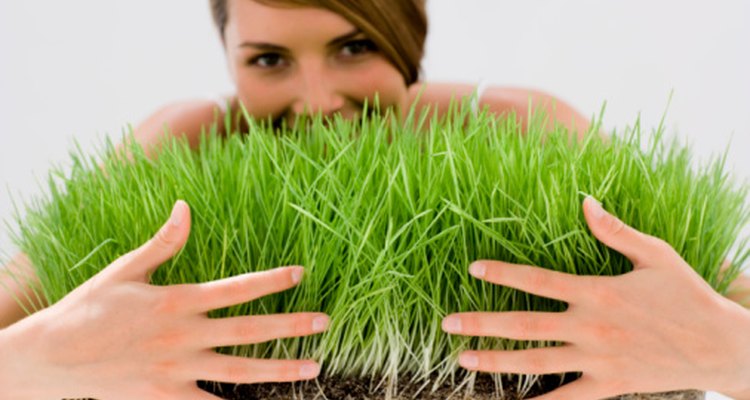
Wheatgrass has many benefits, the Hippocrates Institute reports, ranging from lowering your blood pressure to restoring your gray hair to its natural hue. It is also a treatment for sagging skin, both Hippocrates and Dogwood Gardens Organic Farms say. While the Mayo Clinic gives wheatgrass a nod for its nutritional value, the clinic also warns that no significant research backs up other claims that surround wheatgrass. Wheatgrass also has a few warnings. Consult with your doctor before including wheatgrass in your diet.
Explanation
Wheatgrass, as its name implies, is a type of grass from the wheat family that has many nutrients, the Mayo Clinic reports. Some of these nutrients include amino acid, calcium, chlorophyll and magnesium. It also contains several vitamins, namely vitamin A, vitamin C and vitamin E.
Saggy Skin
One of the benefits of wheatgrass noted by both the Hippocrates Institute and Dogwood Gardens Organic Farm is its ability to tighten loose and sagging skin. The Hippocrates Institute says wheatgrass cleanses the blood, gives new life to old cells and significantly slows the aging process.
Usage
While the Hippocrates Institute and Dogwood Gardens agree that wheatgrass gives you tauter, firmer skin, the two do not agree on the way you should use it to achieve that younger-looking skin. Hippocrates advises you to drink the wheatgrass as a juice to rejuvenate your skin, while Dogwood Gardens says to apply the juice directly onto the skin. As with any treatment that's new to you, consult with your physician before trying wheatgrass.
Instructions
If you opt to drink wheatgrass juice, start with 1 oz. per day and gradually increase it to between 2 and 4 oz. each day or every other day, Dogwood Gardens advises. Drink it in small quantities throughout the day on an empty stomach, either two hours after eating or 30 minutes before. If you apply wheatgrass as a topical application, Dogwood Gardens says to rub the pulp directly on your skin. It does not specify how frequently or for how long a duration.
Warnings
Wheatgrass is generally safe, the Mayo Clinic says, although consuming it sometimes comes with some side effects. These include hives, headaches, swollen throat and nausea. Avoid wheatgrass altogether if you are breastfeeding or pregnant, and check with your doctor before consuming wheatgrass if you are allergic to wheat or grass, are intolerant of gluten or have celiac disease. Also keep in mind that wheatgrass, or any herbal remedy, should not be used as a cure-all or in place of a medical treatment plan advised by your doctor.
Related Articles

How to Use Wheatgrass for Washing Hair

The Use of Neem Juice in Skin Care as ...

Grapefruit Skin Benefits

Bitter Melon for Acne

Pomegranate Juice & Acne

How to Juice a Daikon Radish

How to Keep Cucumber Juice Fresh

What Are the Benefits of Extrapone ...

What Are the Benefits of Aloe Vera & ...

How Long Will Pineapple Juice Stay Good ...

How to Juice Kohlrabi

Nutrition Information on Blueberries

How to Get Rid of Purple Scars

How to Juice Kiwi Fruit

Nutrition in Barley Grass

How to Make Calendula Tea

Grapefruit Seed Extract for Melasma

Aloe Vera Gel As a Wrinkle Reducer

How to Blanch Tomatillos

Zinc Treatment for Rosacea
References
Photo Credits
Jupiterimages/Pixland/Getty Images